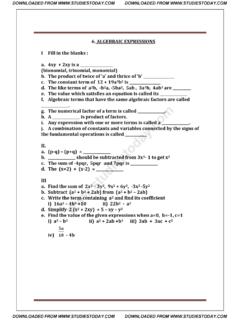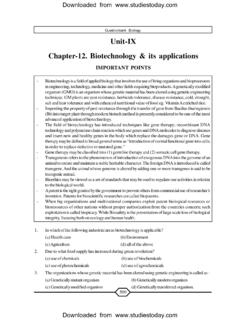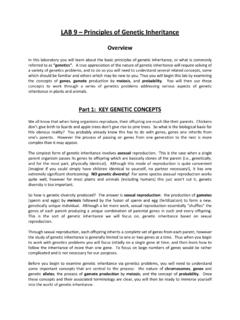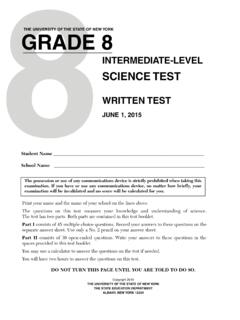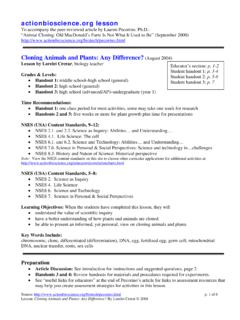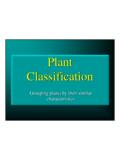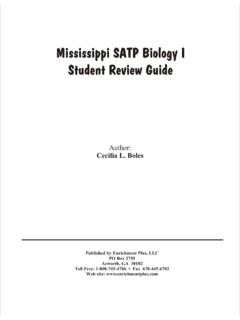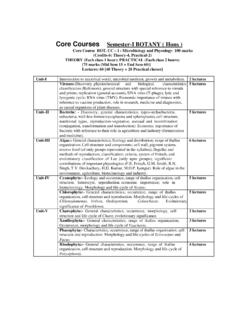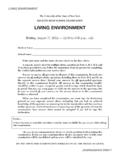Transcription of Unit-II Chapter-7 & 8. Morphology of Plants
1 59 Questionbank Biology Unit-IIChapter-7 & 8. Morphology of PlantsIMPORTANT POINTSF lowering Plants are the most dominant Plants of the earth, exhibit some variations inmorphology, possess well-developed shoot and root systems, which is positively geotropic andhydrotropic and negatively phototropic, and develops from radical. Dicot Plants have tap root systemand monocots have fibrous root system. Roots help in fixation of plant in soil, and absorption of waterand minerals. They also help in storage of food, mechanical support, climbing, photosynthesis, respiration,absorption of moisture, parasitism, symbiosis and reproduction. On the other hand, shoot system isdeveloped from plumule, negatively geotropic and hydrotropic, and positively phototropic, which isdifferentiated into stem, leaves, flowers and fruits. Stem possesser node, internode, leaves, hairs, axillary& apical helps in storage of food, reproduction, protection, climbing and the basis of types of venations, there are two types of leaves reticulate and parallel.
2 Leaves arealso of two types simple and compound. On the basis of arrangement, of leaves are of three types alternate, opposite and whorled. Leaves help in storage of food, support, climbing and of flowers is known as Inflorescence, which is of two types racemose andcymose. A typical flower consists of four whorls calyx, corolla, androecium and gynoecium. Arrangementof sepals or petals in flower is called aestivation, which are five types valvate, twisted, imbricate,quincuncial and vexillary. Of these, androecium is composed of stamens, which may be free or united;Each stamen consits of filament, anther and connective, while gynoecium is made up of carpels, consistsof stigma, style and ovary. Arrangement of ovules within ovary is known as placentation, which may bemarginal, axile, parietal, basal and central. After fertilization, ovary is converted into fruit and ovules intoseeds.
3 There are three types of fruits simple, aggregate and composite. Fleshy fruits are of three types drupe, berry and pome. Seeds are either monocotyledonous or dicotyledonous, exospermic orendospermic. Floral features of any plant is exhibited by floral diagram and floral root in maize develop from:(a) Lower internodes(b) Lower nodes(c) Upper nodes(d) None of the above2. Which of the following Plants have root pockets?(a) Eichhorinia(b) Capparis(c) Opuntia(d) which of following, the Plants have all roots?(a) Podostemon(b) Lemna(c) Wolffia(d) present in bulbil occurs in:(a) Root(b) Stem(c) Leaf base(d) PetiolesDownloaded from from which pont of root, root hairs develop ?(a) Region of maturation(b) Region of elongation(c) Meristematic region(d) Region of root cap6. Epiphytic roots are found in :(a) Indian rubber(b) Orchid(c) Tinospora(d) Cuscuta7.
4 Potatoes are borne on :(a) Primary roots(b) axil of scaly leaves(c) Lateral roots(d) Adventitious plans have rhizome and roots as underground structures. Which characteristics of rhizomewould distinguish them from roots?(a) Rhizomes are thicker than roots.(b) Rhizomes have scaly leaves(c) Rhizome are thinner than roots(d) None of the potato is a modification of:(a) Primary root(b) leaf(c) underground root(d) Adventitious are differentiated into adventitious roots by their:(a) Function(b) appearance(c) place of origin(d) petiole is found in;(a) citrus(b) acacia(c) radish(d) one of the following the stem performs the function of storage and propagation:(a) Ginger(b) Wheat(c) Radish(d) are attached to the stem at :(a) Apical meristem(b) Internode(c) Nodes(d) Axillary meristem14. Phyllotaxy refers to;(a) Arrangement of leaves on stem(b) Folding leaf in the bud(c) (a) & (b) both(d) None of the with jointed stem and hollow internodes are known as :(a) Clums(b) Scape(c) Ephemerals(d) take part in :(a) Sexual reproduction(b) Respiration(c) Transpiration(d) Vegetative is very much reduced in:(a) Tuber(b) Bulb(c) Corm(d) is a stem and not a root because :(a) It stores food material(b) It grows parallel to soil surface(c) It has nodes and internodes(d) It has chlorophyll19.
5 A potato tuber is underground stem because:(a) It has swollen and non-green(b) It possesses axillary buds(c) It possesser starch as stored food.(d) It possess starch as stored foodDownloaded from from are examples of the following type of stem:(a) Suckers(b) Runners(c) Stolon(d) root is name of:(a) Carrot(b) Sweet potato(c) Potato(d) Beet sacs or bladders are found in:(a) Utriculariya(b) salvinia(c) nepenthes(d) Hydrilla23. Which would do maximum harm to a tree ? The loss of:(a) Half of its branches(b) All of its leaves(c) Half of its flower(d) Half of its dicotyledonous parasitic plant of the world is: (JIPMER 1997)(a) Coryadalis nana(b) Primula minutissina(c) Arcethobium minustissimum(d) Marsilea minuta25. Adventitious roots: (AFMC:1994,Chandigadh CETs 1997)(a) Develop from radical(b) Develop from flower(c) Develop from embryo(d) Develop from any part of plant body except radical26.
6 The arrangement of leaves on stem is called:(a) Venation(b) Vernation(c) Phyllotaxy(d) Axis27. Stem modified into flattened photosynthetic structure is:(a) Phyllode(b) Bulbil(c) Phylloclade(d) Tendril28. Nodulated roots occur in: ( 1995)(a) Leguminoceae(b) Solanaceae(c) Malvaceae(d) Papilionaceae29. Insectivorous Plants catch insects for obtaining:(a) Na - K(b) Taste(c) Phosphorus(d) Nitrogen30. Petiole is modified into tendril in(a) Passiflora(b) Gloriosa(c) Pisum(d) clematis31. Thorn is a stem structure because it:(a) Develops from trunk(b) Develops from apical bud(c) modification of bank floralbud(d) is pointed32. Vegetative reproduction of Agave occurs through:(a) Rhizome(b) Stolon(c) Bulbils(d) Sucker33. What is the eye of potato ?(a) Axillary bud(b) Accessory bud(c) Adventitious bud(d) Apical bud34.
7 If a raceme inflorescence is branched , it is call?(a) Umbel(b) spike(c) Cymose(d) PanicleDownloaded from from Biology35. Zig-zag development of inflorescence axis is an example of:a) Helicoid cymeb) Scorpioidc) Umbeld) Compound umbel36. Opposite decussate phyllotaxy is found in:a) Calotropisb) Mangoc) Hibiscusd) Nerium37. A brightly coloured bract like covering associated with the banana inflorescence is called:a) Spatheb) Scapec) Spirald) is :a) Number of flower present on an axisb) Arrangement of flowers on an axisc) Method of the opening of flowerd) Type of flower borne on monocot male gametophyte is: ( )a) Megasporeb) Nucleusc) Microspored) Tetrad40. A catkin of unisexual flower is found in:a) Mulberryb) Wheatc) Oniond) is a :a) Modified coneb) Modified spikec) Modified branch systemd) Modified reproductive shoot42.
8 Flowers are always present in :(a) Cryptogamous(b) Pteridophytes(c) Angiosperms(d) formula represents :(a) number and arrangement of floral parts(b) Number of flowers in an inflorescence(c) Type of flowers in a family(d) None of above44. From the life cycle point of view the most important part of a Plants is:a) Flowerb) Leafc) Stemd) vexillm, (stan dard) wings and keel in pea flowers constitute:a) Calyxb) Corollac) Androeciumd) Gynaecium46. Diadelphous condition is present on:a) Citrusb) Bombyxc) Pisumd) of female flowers in a cyathium is:(keralaCET,05 UPCPMT,07 1995)a) Oneb) Twoc) Threed) is found in a flower in which :a) Calyx and Corolla are not distinguishableb) Stamens are leaf likec) Corolla leaf- like but calyx is coloredd) None of the aboveDownloaded from from with free anthers but filaments fused into a number of groups are;a) Polyadelphousb) Diadelphousc) Monadelphousd) is a modification of :a) Calyxb) Corollac) Stamensd) in legumes is: ( , 19977)(a) Basal(b) Marginal(c) Axile(d) Free central52.
9 The leaves are modified into tendrils, hooks, pitcher ,and bladder in the following plantsrespectively:a) sweet pea, bignonia, Nepenthes, Utriculariab) sweet pea, bignonia, Utricularia, Nepenthes,c) Nepenthes , bignonia, sweet pea, Utriculariad) Utricularia, Nepenthes, bignonia, sweet apex is modified into tendril in:(a) Smilax(b) Gloriosa(c) Australian acacia(d) Pea54. A fibrous root system is better adapted than tap root system for:(a) Storage food ( 1993)(b) Anchorage of plant to soil(c) Absorption of water and organic food.(d) Transport of water and organic is not a stem modification? ( 1988)a) Rhizome of Gingerb) Corm of Colocasiac) Pitcher of Nepenthesd) tuber of pair of insectivorous plant is: ( 1999)a) Dionaea and viscumb) Nepenthes and bladderwortc) Drosera and rafflesiad) Venus fly and phyllode is a modified: (Kerala CET 2004)a) leafb) stemc) rootd) underground specialized shoot with reduced disc like stem covered by fleshy leaves is:( 2000)a) bulbb) Rhizomec) rhizophored) tendril modification is found in : (Pb.
10 PMT2001)a) Smilexb) Peac) Guavad) Mimosa pudica60. Viscum is: (AFMC 2004)a) total stem parasiteb) total root parasitec) partial stem parasited) partial root pocket does not occur in : (Orrisa 2004)a) Ipomoeab) Mangrove plantsc) trapad) pistiaDownloaded from from are: (JKCMEE 2004)a) leaf modificationb) one internode and long stemc) modified petiolesd) green succulent stem of indefinite of Utricularia and Pitchers of nepenthes are modifications of: (JKCMEE 2004)a) leavesb) stemsc) rootd) flowers64. Tallest gymnosperm : (AFMC 2006)a) sequoiab) Eucalyptusc) Pinusd) Eyes of the potato tuber are : ( )a) Root budsb) Flower budsc) Shoot budd) Axillary buds66. Vexillary aestivation is characteristic of the family:a) Asteraceaeb) Solanaceaec) Brassicaceaed) plant live in: (a) Alpine Tundra(b) Tundra (c) Marshy areas along rivers (d) Marshy areas along sea are likely to be found in:(a ) Tropical rain forest(b) Deciduous forest(c) Deserts(d) a compound umbel each umbellate is subtended by:(a) Involucre(b) Bracket(c) Involucel(d) Bracteole70.


